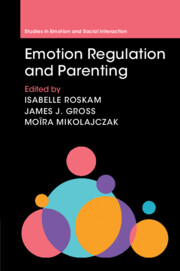A great deal has been written about emotion regulation on the one hand and about parenting on the other. So why is a book at the intersection of these two fields needed?
Parenting, even more than other types of social contexts, activates frequent, lasting, diverse, complex, and often intense emotions. These emotions are considered an essential ingredient of parenting and of the parent–child relationship, and parents must regularly adapt to the child’s constantly changing emotional complexity and emotional competencies. Parenting thus provides a unique context within which emotion regulation not only occurs but matters.
One particularly intriguing feature of emotion regulation in the parent–child relationship is that it is not only bidirectional (i.e. emotion regulation by the parent and emotion regulation by the child influence each other, and both impact the behavior, development, and health of both parent and child) but also asymmetrical. The parent and the child do not have the same level of maturity. Consequently, the parent is supposed to be the emotional expert, at least until the end of adolescence. In order to gradually share their expertise with the child, the parent must ensure that the child learns something beneficial and must make great regulatory efforts to prioritize the desired emotional states for the child, even if this goes against the parent’s own desired emotional states or involves counter-hedonic regulation of the parent’s own emotions (such as downregulating their joy by forcing themselves not to laugh at the child’s naughty behavior).
The desired emotional states for oneself as a parent and for the child are highly dependent on culturally specific norms that set the standards for “good” parenting and define which emotions parents are supposed to feel while parenting and which emotions parents are supposed to elicit/inhibit in their children. These are highly culture dependent. For instance, American parents are invited to elicit pride in their children, whereas Chinese parents are invited to inhibit this same feeling in their children and elicit humility.
Whatever one’s cultural context, the demands on parents can seem daunting. Since they are responsible for the development and well-being of their children, parents must demonstrate high emotion regulation skills. In particular, they must regulate their own and the child’s emotions, sometimes simultaneously, and at other times sequentially. And the success of self-focused emotion regulation is often dependent on the success of other-focused regulation. Moreover, self-focused regulation must not be overdone. The parent must remain in touch with their own emotions in order to avoid being emotionally distant from the child and to mirror the child’s inner world and empathize with what the child is experiencing.
In short, the parent must express the right emotions at the right time, with the right intensity and frequency, in order to maximize the beneficial effects on the child’s development. The term “work” or “labor” used by some authors to designate emotion regulation in parenting illustrate the importance of these regulatory efforts but also the burden that they can sometimes entail. Because some parents feel insufficiently equipped or have difficulties in fulfilling this demanding work, experts in parenting and emotion regulation are developing supportive interventions to train parents (according to cultural standards), increase their resilience, and maximize the benefits for both parents and children.
The chapters of this book take us on a journey through contemporary parenting culture and showcase the crucial role of emotion regulation for the health and development of children and their caregivers. Part I of the book lays out the foundations of emotion regulation on the one hand and parenting on the other. Part II documents what is known about how parents’ regulation of their own emotions is related to parenting. Part III provides an overview of the latest findings on the influence of parenting on the child’s emotional regulation. Part IV aims to pinpoint current trends in research within this promising field. The book concludes with a chapter that examines the scope of the field, the challenges that lie ahead, and some of the promising future directions that lie at the intersection of parenting and emotion regulation.

